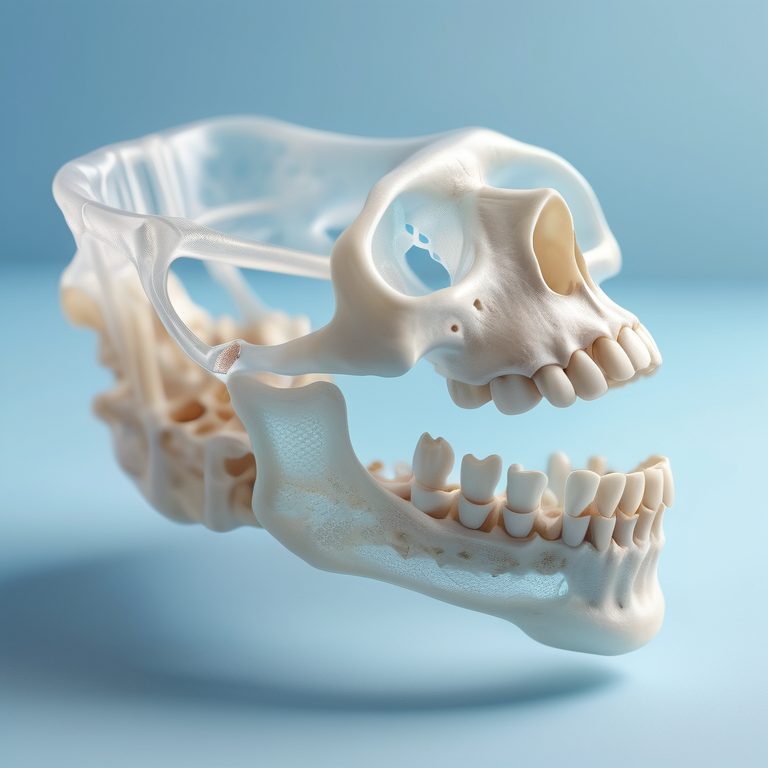Before using dental implants to replace severely damaged or missing teeth, some patients may need a bone graft. A bone grafting procedure is used to provide a strong, stable, and sturdy foundation for dental implants. Understanding bone grafting and its role in dental health is essential for those considering dental implants.
Understanding Bone Grafting in Dentistry

Bone grafting is a surgical procedure that uses transplanted bone to repair and rebuild damaged or diseased bones. It can be performed on bones anywhere in the body, including the jaw. In dentistry, bone grafts are commonly used to build up the jaw if it is too soft or thin. This procedure helps create a strong base for dental implants by allowing the body to deposit new bone cells around the graft material.
The Role of Bone Grafts in Dental Health
Bone grafts play a crucial role in dental health by providing the necessary support for dental implants. When a tooth is lost or extracted, the surrounding bone can start to deteriorate. By placing a bone graft in the empty socket, new bone cells are stimulated to grow, strengthening the jawbone and providing a stable foundation for the dental implant. This process helps prevent further bone loss and maintains the overall oral health of the patient.
Different Scenarios Requiring Bone Grafts
There are several scenarios in which a bone graft may be necessary in dental care:
- Tooth loss: When a tooth is lost and not replaced, the surrounding bone can start to deteriorate. Bone grafting can help rebuild the jawbone to support a dental implant.
- Tooth extraction: In some cases, bone grafting may be required after a tooth extraction to preserve the bone and prepare the site for a future dental implant.
- Missing teeth: If a patient has been missing teeth for a long time, bone loss can occur. Bone grafting can restore the bone density and volume necessary for successful dental implant placement.
- Bone loss: Certain conditions, such as advanced gum disease or trauma to the facial area, can result in bone loss. Bone grafting can help rebuild the affected areas and provide a stable base for dental implants.
Types of Bone Grafts Used in Dentistry
There are different types of bone grafts used in dentistry, each with its own advantages and applications. These include autografts, allografts, xenografts, and synthetic options.
Autografts: Using Your Own Bone
Autografts involve using a patient’s own bone tissue for the graft. The bone is typically taken from the hip bone. Using autografts has the advantage of reducing the risk of rejection since it is the patient’s own tissue. However, there is a limited amount of bone that can be collected, and there may be pain and discomfort at the donor site. Autografts have proven to be highly successful in promoting new bone growth and integration with the existing bone.
Allografts: Donor Bone Options
Allografts involve using bone tissue from a donor. This bone tissue is carefully sterilized and cleaned to ensure the safety of the recipient. Allografts provide a framework for new bone growth, as the body gradually replaces the donor bone with its own bone cells. This type of bone graft is commonly used in dental procedures and has been proven to be effective in promoting bone regeneration and integration. The use of allografts eliminates the need for additional surgery to collect the patient’s own bone tissue.
Xenografts: Animal Bone Sources
Xenografts involve using bone graft material from animal sources, usually bovine or porcine. The animal bone is carefully processed to remove any organic material, leaving behind the mineral structure. Xenografts serve as a scaffold for new bone growth, stimulating the body’s natural healing process. Over time, the animal bone is gradually replaced by the patient’s own bone, resulting in a fully integrated graft. Xenografts are widely used in dental procedures and have been shown to be safe and effective in promoting new bone growth.
Synthetic Options: The Future of Bone Grafting
Synthetic bone grafts are artificially produced materials that mimic the structure and properties of natural bone. These grafts are made from a variety of porous substances, some of which may contain proteins for enhanced bone development. Synthetic bone grafts offer several advantages, including unlimited availability, reduced risk of disease transmission, and the potential for customization. Research and advancements in synthetic bone graft materials continue to improve their effectiveness in promoting bone healing, particularly in cases of advanced gum disease or other challenging oral health conditions.
The Bone Grafting Procedure Explained
The bone grafting procedure involves several steps, from pre-procedure assessments to the surgical procedure itself, and post-procedure recovery and care.
Pre-Procedure Assessments
Before undergoing a bone grafting procedure, your dentist will conduct pre-procedure assessments to evaluate your oral health. This may include taking a CT scan of your jawbone to assess the extent of bone loss and determine the appropriate treatment plan. These assessments help your dentist customize the procedure to your specific needs. If you are considering a bone graft for dental health, it is important to schedule an appointment with your dentist today to discuss your options and determine the best course of action.
Step-by-Step: What Happens During the Procedure
During the bone grafting procedure, you will be temporarily put to sleep with anesthesia to ensure your comfort. Your surgeon or dentist will carefully monitor your vital signs, such as blood pressure and heart rate. The surgeon will then clean the affected area and make an incision to access the bone that will receive the graft. Depending on the specific case, the bone graft may be taken from your leg bone, hip bone, or ribs. The surgeon will insert the bone graft between the two pieces of bone that need to grow together, using special tools if necessary. Any other necessary repairs will be made, and the incision will be closed surgically. The procedure is considered a minor surgical procedure and is often performed in conjunction with dental implant surgery.
Post-Procedure: Recovery and Care
After a bone grafting procedure, the healing process begins. It is important to follow your dentist’s instructions for post-procedure care to ensure proper healing and minimize the risk of complications. You may experience some discomfort or pain, but your dentist can prescribe pain medication to alleviate any discomfort. It is also important to maintain overall health, including a healthy diet and good oral hygiene practices. Be sure to attend all follow-up appointments with your dentist to monitor the progress of your healing and address any concerns or questions you may have.
Indications for a Bone Graft in Dental Care
A bone graft may be indicated in dental care for several reasons, including supporting dental implants, addressing periodontal disease issues, and reconstructive surgery necessities.
Supporting Dental Implants
When considering dental implants, it is important to have enough healthy bone in the jaw to support the implant. If the bone is weak or insufficient, a bone graft may be necessary to build up the jawbone before implant placement. A strong foundation is essential for the long-term success of dental implants, as it ensures stability and prevents implant failure. A bone graft can provide the necessary support and ensure a successful outcome for dental implant surgery.
Addressing Periodontal Disease Issues
Periodontal disease, also known as gum disease, can lead to bone loss in the jaw. If left untreated, this bone loss can compromise the stability of the teeth and result in tooth loss. In cases where periodontal disease has caused significant bone loss, a bone graft may be necessary to rebuild and strengthen the jawbone. By addressing the underlying gum disease and restoring the bone structure, a bone graft can help preserve the patient’s natural teeth and improve overall oral health.
Reconstructive Surgery Necessities
In some cases, reconstructive surgery may be necessary to restore facial features and bone structure. This could be due to congenital defects, trauma, or previous surgical procedures. A bone graft can provide the necessary framework for rebuilding and reshaping the affected area, allowing for proper healing and restoration of facial aesthetics. Reconstructive surgery often requires a combination of bone grafting techniques to achieve the desired results. By working with a skilled oral and maxillofacial surgeon, patients can undergo successful reconstructive procedures and regain both function and aesthetics.
Contact Holmes Dental PC Today
In conclusion, understanding the role of bone grafts in dental health is crucial for addressing various oral health issues effectively. Whether it’s supporting dental implants, treating periodontal diseases, or reconstructive surgeries, bone grafting plays a vital role in restoring dental function and aesthetics. By exploring the different types of bone grafts available and the procedure involved, you can make informed decisions regarding your dental care. If you have any questions about bone grafting or need guidance on choosing the right type of bone graft for your specific needs, do not hesitate to consult with us for personalized advice and support. Your dental health is worth investing in for a confident and healthy smile.
Frequently Asked Questions
When is a Bone Graft Necessary?
A bone graft is necessary when a patient requires a dental implant but has insufficient bone in the jaw to support the implant. It is also necessary in cases of bone loss due to missing teeth or other oral health conditions.
How Long Does It Take to Recover from a Bone Graft?
The recovery time from a bone graft procedure varies depending on the individual and the extent of the graft. Generally, it takes several weeks to several months for the bone graft to fully integrate and heal. Factors such as overall health, proper post-procedure care, and adherence to the dentist’s instructions can contribute to the speed of recovery.
Can Bone Grafts Fail? What are the Signs?
While rare, bone grafts can fail in some cases. Signs of failure include persistent pain, swelling, or infection at the graft site. If these signs occur, it is important to consult with your dentist for further evaluation and necessary repairs. Regular follow-up appointments and proper oral care can help prevent graft failure.
How to Choose the Right Type of Bone Graft?
Choosing the right type of bone graft depends on various factors, including the patient’s specific needs, oral health condition, and bone quality. Your dentist will evaluate your individual case and recommend the most suitable type of bone graft to ensure successful integration and long-term results.







